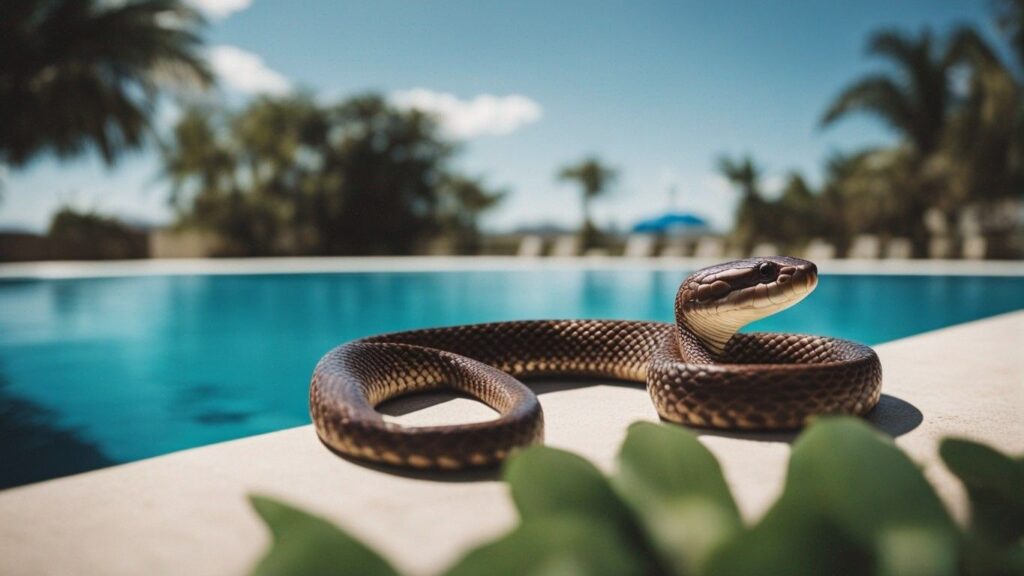Imagine lounging by the refreshing waters of your backyard pool on a scorching summer day, when suddenly, you spot a slithering serpent skimming across the water’s surface.
Your peaceful oasis has been invaded by an unexpected guest – a snake. But why is it here? In this article, we will explore the fascinating question, “Do pools attract snakes?” Uncover the reasons behind snakes being drawn to pools and discover effective measures to keep them at bay.
So, grab a drink and dive into this captivating exploration of the curious relationship between pools and snakes.
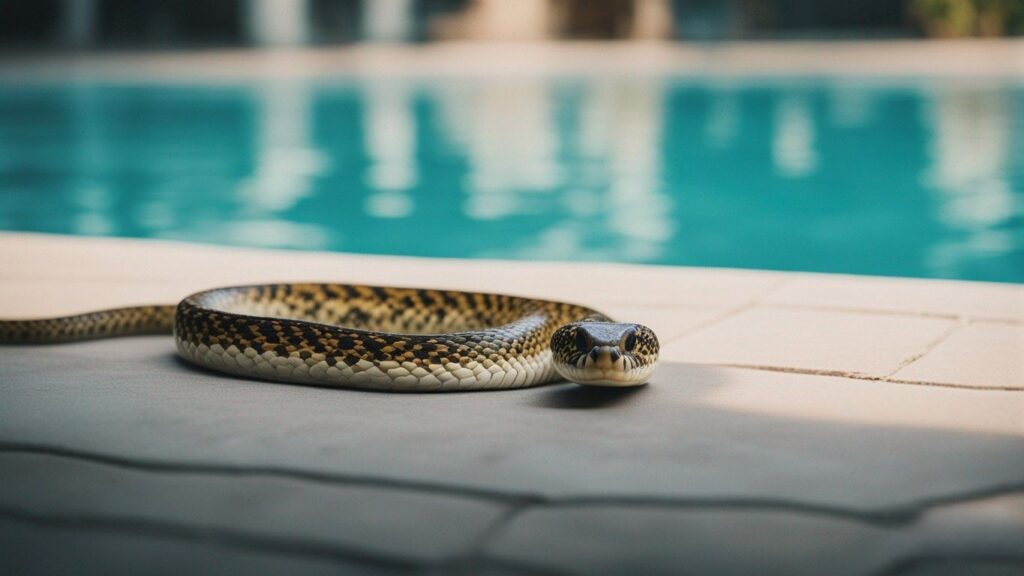
Factors that Attract Snakes to Pools
Shallow Water as a Convenient Spot for Drinking
One of the factors that attract snakes to pools is the availability of shallow water. Snakes need to drink regularly to stay hydrated, and pools provide a convenient water source for them.
Since many pools are designed with steps or ledges, it creates a shallow area where snakes can easily access the water without having to fully submerge themselves.
This makes pools an attractive spot for snakes to quench their thirst.
Abundance of Prey
Another reason why snakes are drawn to pools is the abundance of prey that can be found in and around them.
Pools often attract various small animals such as frogs, lizards, rodents, and insects. These serve as a food source for snakes, and the presence of an abundant prey population can make pools an appealing hunting ground for them.
The calm water of the pool also makes it easier for snakes to spot and catch their prey.
Escape from Predators
Pools can provide a safe haven for snakes, allowing them to escape from potential predators.
Snakes have their fair share of threats in the wild, including larger predators like birds of prey and mammals.
When a snake senses danger, it may seek refuge in a pool, as it provides a barrier between them and their predators.
The water not only acts as a physical obstacle but also makes it difficult for predators to track their scent, giving snakes a better chance of survival.
Heat and Humidity
Snakes are ectothermic animals, meaning they rely on external sources of heat to regulate their body temperature.
Pools offer a desirable combination of heat and humidity, especially in sunny and warm climates.
Basking near or even inside the pool helps snakes absorb heat from the sun, allowing them to warm up their bodies and maintain their optimal temperature.
The water in the pool also aids in maintaining the necessary humidity levels for snakes’ respiratory health.
Importance of Water for Reproduction
Water plays a crucial role in the reproductive cycle of certain snake species. Some snakes, such as the Nerodia sipedon (common water snake) and the Nerodia rhombifer (diamondback water snake), are aquatic or semi-aquatic and require water for mating and egg-laying.
Pools provide an attractive breeding ground for these snakes, as they offer a suitable environment for courtship rituals and the subsequent reproduction process.
Consequently, pools can serve as a magnet for these species during their breeding season.
Pool Characteristics that Attract Snakes
Shallow and Calm Water
Snakes are more likely to be attracted to pools that have shallow and calm water. The shallow water allows them to easily access the pool without much effort, and the calmness of the water surface makes it easier for them to spot and capture their prey.
Additionally, shallow and calm water provides an ideal environment for courtship and mating behaviors for aquatic or semi-aquatic snake species.
Vegetation and Habitat for Prey
Pools surrounded by vegetation and offering habitat for prey species can be particularly enticing to snakes.
Vegetation provides cover for snakes, allowing them to hide while waiting for potential prey to approach.
Furthermore, an abundant prey population, attracted by the presence of surrounding vegetation, creates a favorable hunting ground for snakes.
The combination of vegetation and accessible prey makes these pools more attractive to snakes seeking both shelter and sustenance.
Accessible Sunbathing Spots
Snakes, being cold-blooded, need external sources of heat to warm their bodies and regulate their metabolism.
Pools that provide accessible sunbathing spots, such as paved areas or rocks near the water’s edge, are likely to attract snakes.
These spots allow snakes to absorb heat from the sun, helping them raise their body temperature to an optimal level.
The proximity of these warm spots to the pool provides convenience for snakes to bask and retreat to the water when necessary.
Hidden and Dark Areas for Shelter
Snakes seek out pools that offer hidden and dark areas for shelter. Such areas may include overhanging plants, crevices between rocks, or debris near the pool.
These hiding spots provide snakes with protection from potential predators and also serve as resting and hunting locations.
Pools with ample hideaway options give snakes a sense of security and make them more likely to frequent the area.
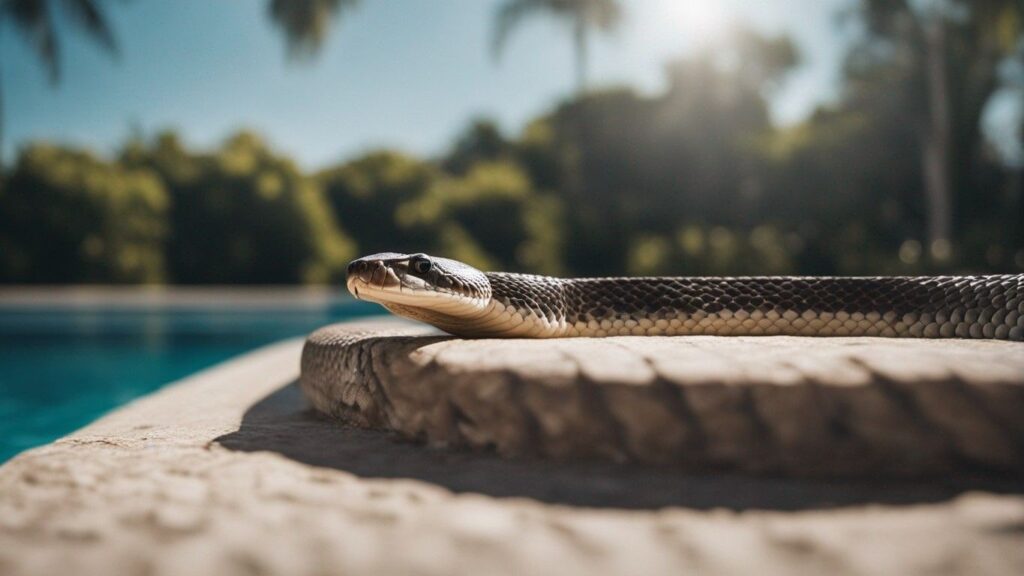
Snake Species Attracted to Pools
Common Water Snake (Nerodia sipedon)
The common water snake, scientifically known as Nerodia sipedon, is a nonvenomous snake commonly found near water bodies, including pools.
These snakes are attracted to pools due to their semi-aquatic nature. They use pools for mating, feeding, and thermoregulation purposes.
Common water snakes are typically harmless to humans but may bite if threatened or provoked.
Garter Snakes (Thamnophis spp.)
Garter snakes, belonging to the Thamnophis species, are another snake species that can be found near pools.
These snakes are known for their adaptability to various habitats, including aquatic environments.
They are attracted to pools for their water source, as well as the availability of their preferred prey, such as small fish, tadpoles, and frogs.
Garter snakes are generally harmless to humans, but cautious handling is advisable to avoid unnecessary stress for both the snake and the individual.
Cottonmouths or Water Moccasins (Agkistrodon piscivorus)
Cottonmouths, also known as water moccasins, are venomous snakes that are commonly associated with aquatic habitats, including pools.
They are attracted to pools due to the availability of both water and prey. While the presence of cottonmouths in pools is cause for concern, it is important to note that they are generally non-aggressive unless disturbed or threatened.
If encountering a cottonmouth, it is best to maintain a safe distance and contact local wildlife authorities for proper removal.
Rat Snakes (Elaphe spp.)
Rat snakes of the Elaphe species are known to be excellent climbers and are often found near residential areas, including pools.
While they are not primarily aquatic snakes, they can still be attracted to pools for various reasons, such as the prospect of finding prey and accessible hiding spots.
Rat snakes are nonvenomous and generally pose no threat to humans.
Diamondback Water Snakes (Nerodia rhombifer)
Diamondback water snakes, scientifically known as Nerodia rhombifer, are semi-aquatic snakes that prefer slow-moving bodies of water, which may include pools.
These snakes are particularly drawn to pools during their breeding season, as they require water for mating and egg-laying.
Diamondback water snakes are nonvenomous and, like other water snake species, tend to avoid confrontation unless provoked.
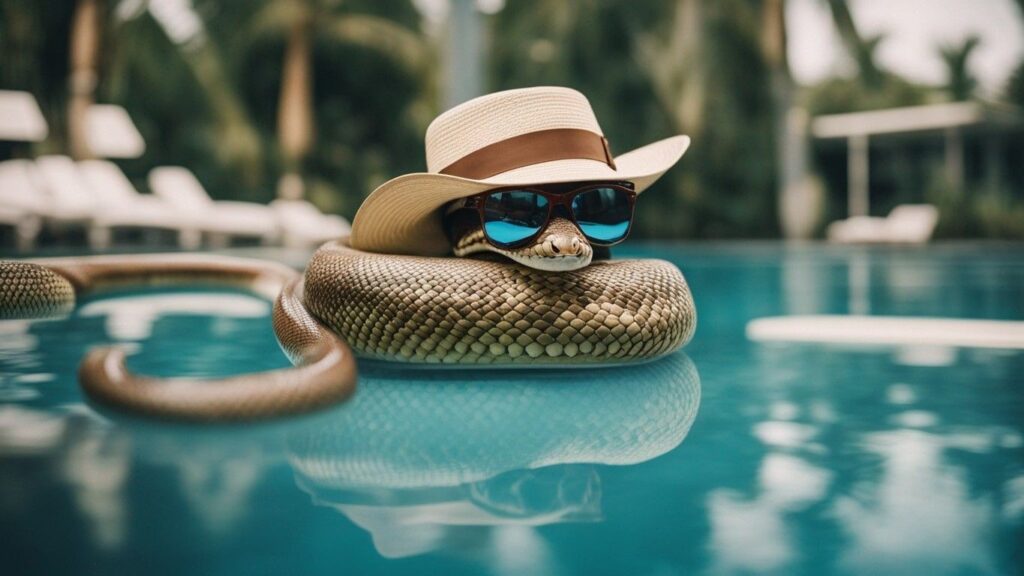
Dangers and Concerns of Snakes in Pools
Potential of Snake Bites
One of the primary concerns of having snakes in pools is the risk of snake bites. While most snakes are nonvenomous and generally avoid human contact, it is still essential to exercise caution when encountering any snake.
Venomous snakes, such as cottonmouths or rattlesnakes, can pose a more significant threat if inadvertently disturbed or threatened.
To minimize the risk of snake bites, it is advisable to familiarize yourself with the snakes in your region and to contact local wildlife authorities for assistance if necessary.
Contamination of Pool Water
Snakes are not known to contaminate pool water or introduce harmful bacteria. However, their presence may result in the introduction of organic matter, such as shed skin, feces, or carrion, into the pool.
This can compromise the water quality and potentially affect pool sanitation. Regular pool maintenance, including proper filtration and routine cleaning, is important to maintain a healthy and safe swimming environment.
Safety Risks for Pool Users
While the majority of snakes are not aggressive towards humans, encounters with snakes in and around pools can still cause alarm and panic.
This can potentially result in accidents if individuals try to flee or react in a way that compromises their safety, such as running or falling.
It is essential to educate pool users about the potential presence of snakes and promote calmness and avoidance when encountering them.
Implementing appropriate solutions, like securing fencing and ensuring proper pool safety measures, can further reduce the risks associated with snake encounters.
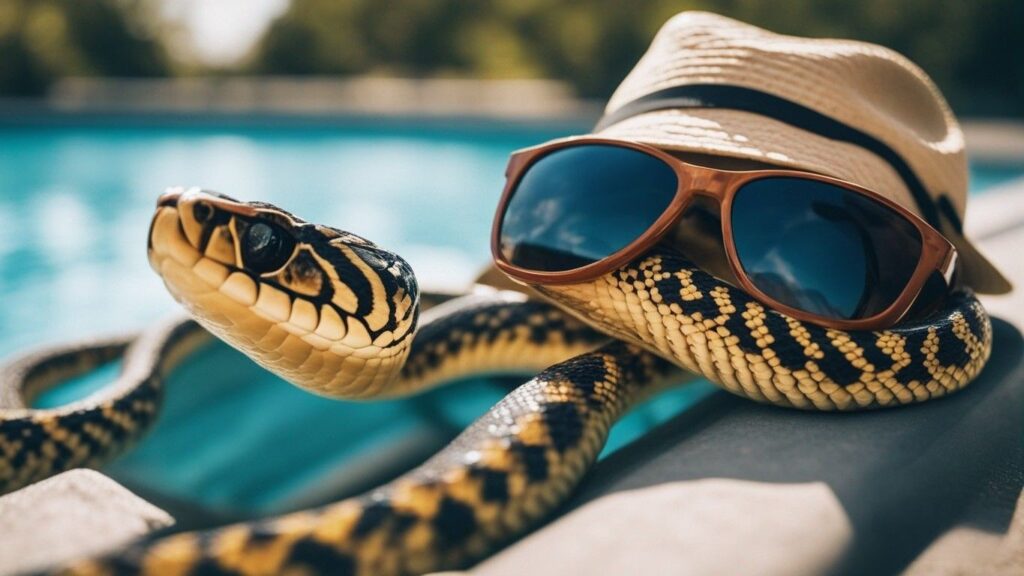
Preventive Measures to Avoid Snakes in Pools
Implementing Snake-Repellent Measures
To deter snakes from entering pool areas, various snake-repellent measures can be implemented.
These include using commercially available snake repellents, which typically contain natural ingredients such as clove oil or cinnamon oil.
Additionally, modifying the landscape around the pool, such as removing excess vegetation and debris, can make the area less attractive to snakes.
It is important to note that while these measures may reduce the chances of snake encounters, they may not provide complete protection.
Ensuring Pool Safety and Maintenance
Maintaining a safe and well-maintained pool is essential to minimize the risks associated with snake encounters.
This includes regularly inspecting and repairing any openings or gaps in pool fences and ensuring that the pool cover is secure when not in use.
Routine cleaning and monitoring of the pool area will help identify potential hiding spots for snakes and allow for prompt removal.
Additionally, proper pool water maintenance, including regular disinfection, will help keep the water clean and reduce the risk of contamination.
Removing Attractive Features for Snakes
To make your pool area less appealing to snakes, it is advisable to remove or minimize features that may attract them.
This includes removing excess vegetation, rocks, and debris that can provide hiding spots for snakes.
Keeping the surrounding area tidy and free from clutter will reduce potential hiding places.
Additionally, removing any potential sources of prey, such as bird feeders or unsecured garbage cans, can help discourage snakes from entering the pool vicinity.
Final Thoughts
In conclusion, several factors attract snakes to pools, including the availability of shallow water for drinking, an abundance of prey, escape from predators, heat and humidity, and the importance of water for reproduction.
Pool characteristics that attract snakes include shallow and calm water, vegetation and prey habitat, accessible sunbathing spots, and hidden areas for shelter.
Different snake species, such as the common water snake, garter snakes, cottonmouths, rat snakes, and diamondback water snakes, may be attracted to pools for various reasons.
It is important to be aware of the potential dangers and concerns associated with snakes in pools, such as snake bites, water contamination, and safety risks for pool users.
Implementing preventive measures, including snake-repellent measures, pool safety and maintenance practices, and removing attractive features for snakes, can help minimize the likelihood of encountering snakes in pools and ensure a safe swimming environment.


